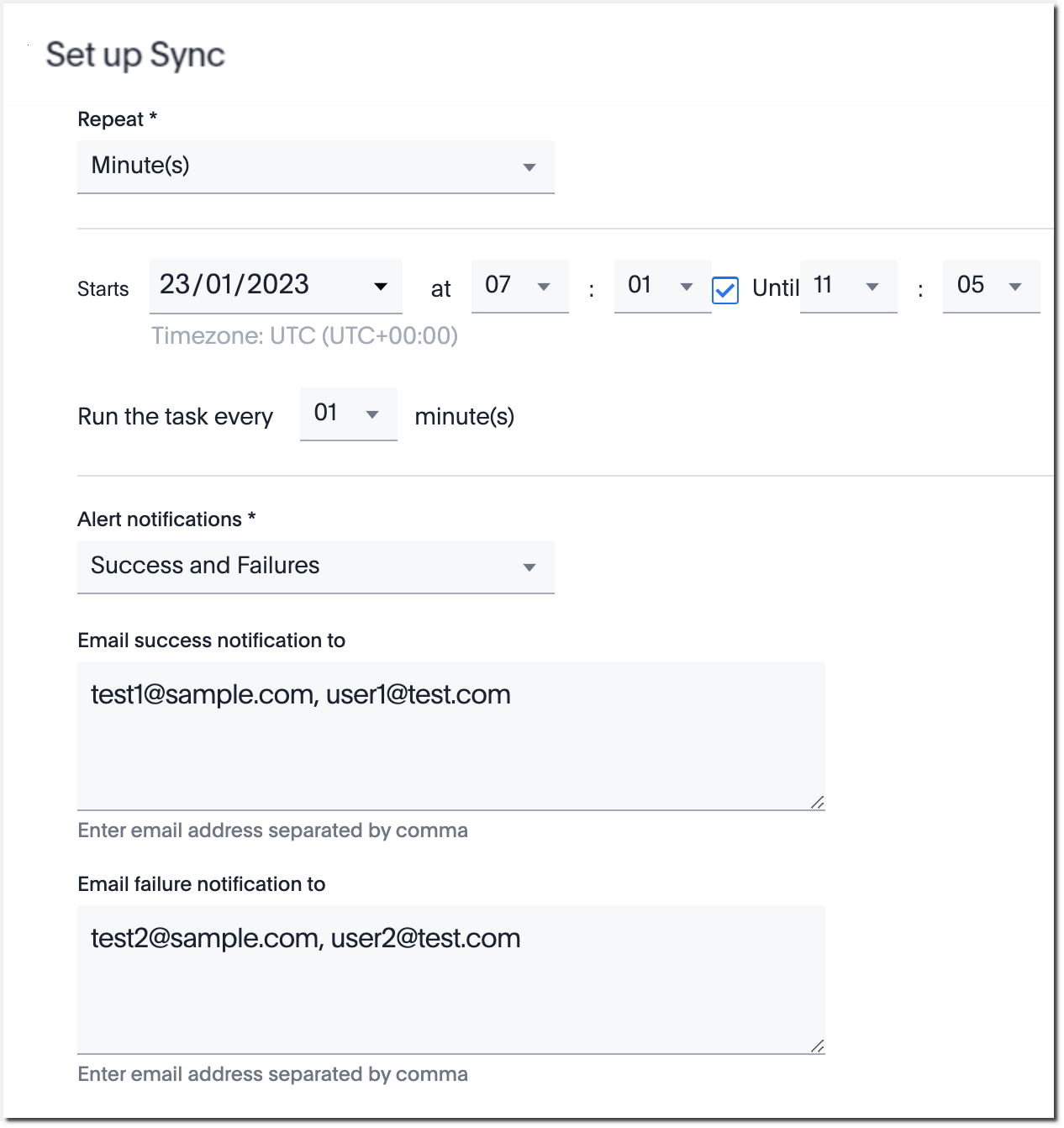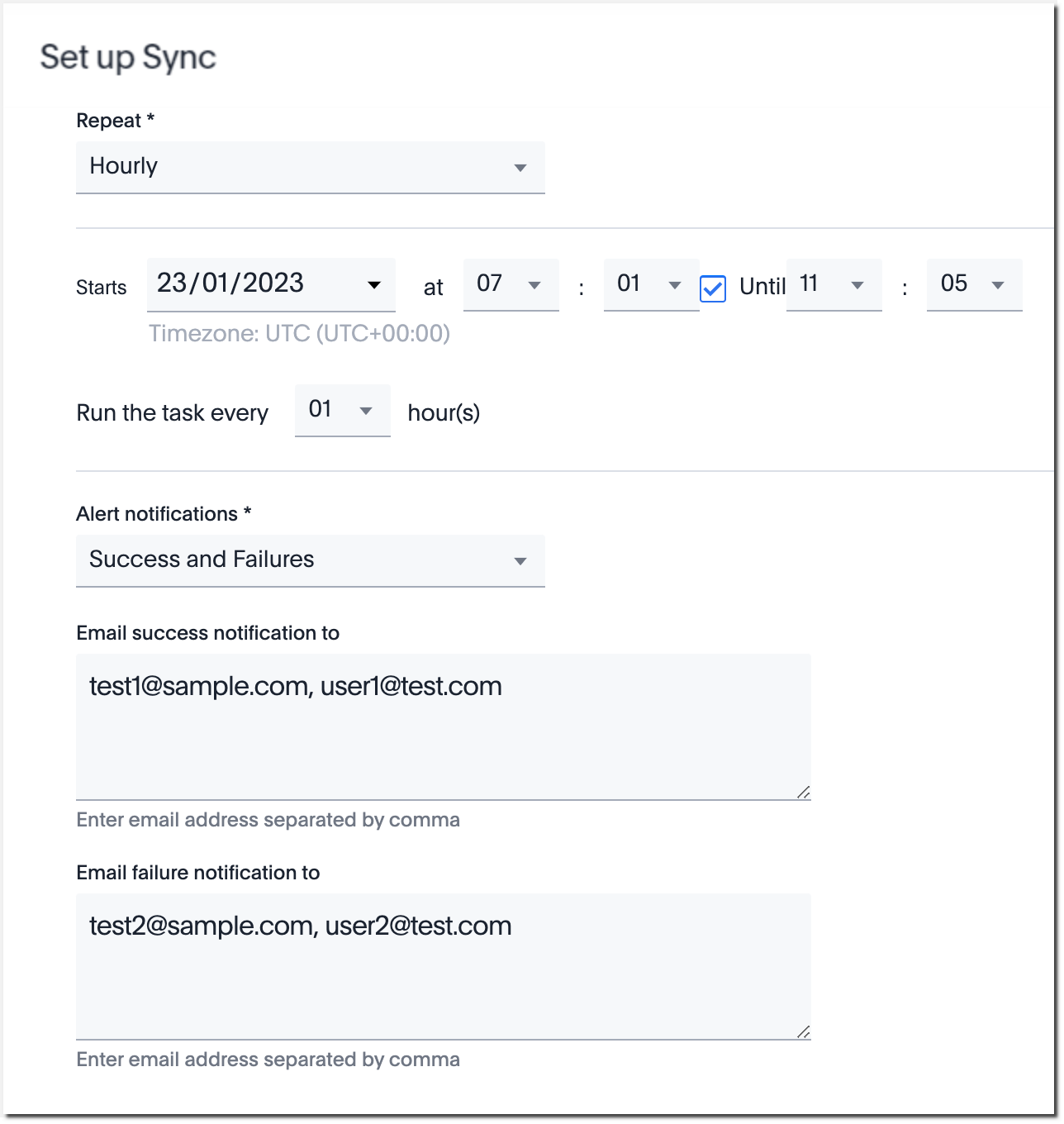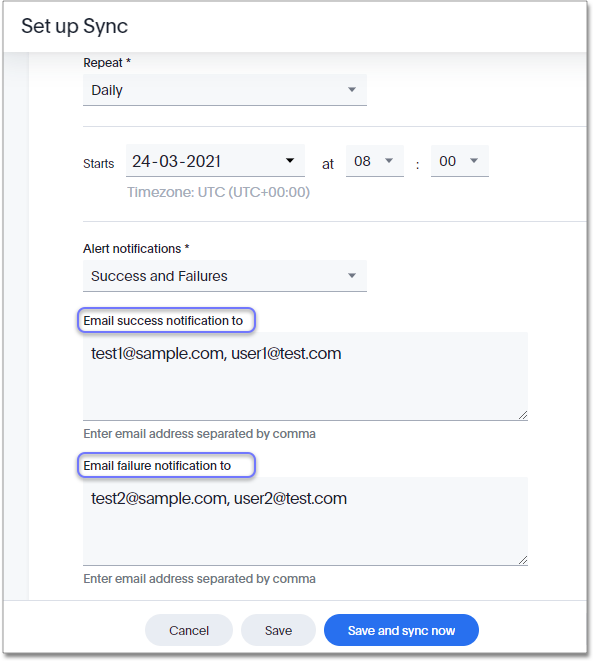Sync data through Amazon S3 connection
After using ThoughtSpot DataFlow to establish a connection to an Amazon S3 file system, you can create automatic data updates, to seamlessly refresh your data.
To sync your data, perform these tasks:
Select file
-
Immediately after creating a new connection, the connection detail page appears.
You can fill out this information immediately, or return to it at a later stage, by clicking on the connection name in the list of connections.
-
On the connection detail page, click Add table sync.
-
In the Add table sync interface, on the database selector, scroll to find the source file, and click to select it.
You can search for the file by name.
If you use multiple files, you have to repeat these steps for each file.
-
In the file detail display, adjust the properties.
Before confirming that you plan to sync a file, examine it to ensure that it has the right information: the correct data types, and reasonable sample data.
For wide files, scroll to the right to see all columns.
- File format
-
Specify the format of the source file.
The options are Delimited, Parquet, JSON, LDJSON, ORC, XML New, and Avro New.
- Column separator
-
Specify the character that signals start of new column.
The options are Comma(,) (default), Semicolon(;), Pipe(|), Space, Tab, or Other.
- Header row
-
Specify if file uses a header row.
- Compression
-
Specify if file uses compression.
The options are None (default), or gzip
-
Click Set up sync.
-
Specify sync schedule
Immediately after creating a new connection, the connection detail page appears.
When you create a sync schedule, you have the following scheduling options:
After you specify the sync schedule, click Save and sync now. This action saves the schedule, and starts the data sync immediately.
Alternatively, if you click Save, the system saves the schedule, but does not sync the data. This gives you the opportunity to fine-tune the column mapping between external data sources and tables inside ThoughtSpot, such as naming, visibility, data type conversion, conditions, and so on. The first sync starts on the specified schedule.
Minute(s) sync
- Repeat
-
Select minute(s).
Mandatory field.
- Starts
-
Accept the defaults, or set your own starting date and time, and end time(until) for syncing.
Note that the timezone is in
UTC+00:00.Mandatory fields.
- Run the task every X minute(s)
-
Select the frequency of the sync.
The valid range is from 1 (default) to 59 minutes.
Mandatory field.
- Alert notifications
-
Specify when to notify of the sync status:
-
Failures (default),
-
Success and Failures
-
Never.
- Email notifications
-
Write a list of recipients to whom success and failure notifications should be sent. Multiple email IDs can be specified as comma-separated values. You must provide this parameter to send an email for both failure and success scenarios.

-
Hourly sync
- Repeat
-
Select hourly.
Mandatory field.
- Starts
-
Accept the defaults, or set your own starting date and time for syncing.
Note that the timezone is in
UTC+00:00.Mandatory fields.
- Run the task every X hour(s)
-
Select the frequency of the sync.
The valid range is from 1 (default) to 12 hours.
Mandatory field.
- Alert notifications
-
Specify when to notify of the sync status:
-
Failures (default),
-
Success and Failures
-
Never.
- Email notifications
-
Write a list of recipients to whom success and failure notifications should be sent. Multiple email IDs can be specified as comma-separated values. You must provide this parameter to send an email for both failure and success scenarios.

-
Daily sync
- Repeat
-
Select daily.
Mandatory field.
- Starts
-
Accept the defaults, or set your own starting date and time for syncing.
Note that the timezone is in
UTC+00:00.Mandatory fields.
- Alert notifications
-
Specify when to notify of the sync status:
-
Failures (default),
-
Success and Failures
-
Never.
- Email notifications
-
Write a list of recipients to whom success and failure notifications should be sent. Multiple email IDs can be specified as comma-separated values. You must provide this parameter to send an email for both failure and success scenarios.

-
Weekly sync
- Repeat
-
Select weekly.
Mandatory field.
- Starts
-
Accept the defaults, or set your own starting date and time for syncing.
Note that the timezone is in
UTC+00:00.Mandatory fields.
- Days of the week
-
Select the days of the week when you want to sync.
For example, you may select only Monday, or only Monday through Friday.
Mandatory field.
- Alert notifications
-
Specify when to notify of the sync status:
-
Failures (default),
-
Success and Failures
-
Never.
- Email notifications
-
Write a list of recipients to whom success and failure notifications should be sent. Multiple email IDs can be specified as comma-separated values. You must provide this parameter to send an email for both failure and success scenarios.

-
Monthly sync
- Repeat
-
Select monthly.
Mandatory field.
- Starts
-
Accept the defaults, or set your own starting date and time for syncing.
Note that the timezone is in
UTC+00:00.Mandatory fields.
- Day of the Month
-
Select the days of the month when you want to sync.
Mandatory field.
There are two basic approaches:
- Cardinal day
-
Click the Day selector, and choose by date of the month from drop down menu.
For example, select
15to run sync on 15th of each month. - Ordinal day
-
Click the The selector, an choose one of First(default), Second, Third, Fourth, or Last. Then choose one of the days of the week, Sunday through Saturday.
- Alert notifications
-
Specify when to notify of the sync status:
-
Failures (default),
-
Success and Failures
-
Never.
- Email notifications
-
Write a list of recipients to whom success and failure notifications should be sent. Multiple email IDs can be specified as comma-separated values. You must provide this parameter to send an email for both failure and success scenarios.

-
Does not repeat
- Repeat
-
Select Does not repeat.
Mandatory field.
- Alert notifications
-
Specify when to notify of the sync status:
-
Failures (default),
-
Success and Failures
-
Never.
- Email notifications
-
Write a list of recipients to whom success and failure notifications should be sent. Multiple email IDs can be specified as comma-separated values. You must provide this parameter to send an email for both failure and success scenarios.

-
Map tables
To map the external files to ThoughtSpot’s internal database, follow these steps:
-
Open the Map tables and columns interface by clicking the toggle to open.
-
The Internal ThoughtSpot storage opens by default.
-
Notice that the filename and its path appear, under Filename.
You can change the name of the file.
-
Specify the following information for internal ThoughtSpot storage:
- ThoughtSpot database
-
Select an existing ThoughtSpot database from the dropdown menu. If you wish to create a new database in ThoughtSpot, click TQL Editor, enter the
CREATE DATABASE my_database;command, and click Execute.
Mandatory field.
- ThoughtSpot schema
-
Select an existing ThoughtSpot schema from the dropdown menu. If you wish to create a new schema in your ThoughtSpot database, click TQL Editor, enter the
CREATE SCHEMA my_schema;command, and click Execute.
Mandatory field.
- New or Existing table
-
Mandatory field.
- Create a new table
-
Choose this option when you want to load data into a new table.
The system creates a new table automatically.
If you want the new table to have some special properties, create the table using the TQL Editor, proceed to Choose existing table, and then select the table you just created.
Click TQL Editor, enter the
CREATE TABLE my_table ...;command, and click Execute.Specify the table name.
- Choose existing table
-
Choose this option to load data into a table that already exists inside ThoughtSpot.
Select the table name from the dropdown menu.
- ThoughtSpot table
-
The name of the target table for data sync, inside ThoughtSpot.
Mandatory field.
Map columns
To map the columns of the external tables to columns in ThoughtSpot’s internal tables, follow these steps:
-
Scroll down to the Map the columns… section.
-
Specify the following information for columns:
Adjust the file parsing properties as necessary: Column separator, Header row, and Compression.
Select (or deselect) columns for syncing into ThoughtSpot.
By default, all columns are selected.
-
Search for columns by name; this is very useful for very wide tables.
-
Rename columns in the ThoughtSpot table, for easier search.
To make this change, click the pencil (edit) icon next to the name of the column. -
Change the data type of the column inside the ThoughtSpot table.
Click the down chevron icon to open the dropdown menu, and select a new data type.
For example, if you know you have integer data, change the default DOUBLE datatype to INT32.
-
Set Primary keys of the table by toggling the selector to the 'on' position.
Note that several columns may be primary keys. - Set the Sharding keys of the table by toggling the selector to the 'on' position. - Specify the Number of shards in the table.
-
-
Save your work by clicking Save.
Alternatively, click Save and sync now to save your work and sync data at the same time.
Set sync properties
Basic sync properties
To set the sync properties, follow these steps:
-
Open the Advanced setup interface by clicking the toggle to open.
-
Choose the Sync properties tab.
-
Under Set sync properties, specify the following information:
- Sync mode
-
Choose the sync mode, either Append or Overwrite.
Mandatory field.
For Append or Overwrite, when the table has a primary key, ThoughtSpot uses UPSERT to update the new rows to the table. - Append
-
This option adds new rows to the table.
- Overwrite
-
This option removes all existing rows, and then adds new rows to the table.
- Default:
-
Sync mode defaults to append.
- Completion
-
Specify what to do with the file after the sync successfully completes.
One of the following options: do nothing, delete the file, or move the file to specified location: directory/path
When you select move it to, the default path is empty. In the text field, provide the path to the location the sync file should move to.
-
Save your work by clicking Save.
Alternatively, click Save and sync now to save your work and sync data at the same time.
Scripting for sync
To use scripting before or after the sync, follow these steps:
-
Open the Advanced setup interface by clicking the toggle to open.
-
Choose the Sync properties tab.
-
Scroll down to Advanced configuration, and click the toggle to expand.
-
Specify the following information:
- Wait for file
-
Specify the fully-qualified name of the file (directory path and file name) that must be present before sync can start.
ThoughtSpot deletes the file after the sync process completes.
- Pre-script
-
Add the script that you want to run before syncing.
Optional field.
- Example:
-
Drop data that is over 1 year old; to find the correct functions for the script, click Expression editor, use it to create a valid command (or several commands), and click OK.
DELETE from FACT_TABLE Where DATE < ADD_DAYS(TODAY(),-365)
- Post-script
-
Add the script that you want to run after syncing.
Optional field.
- Example:
-
Drop data that is over 1 year old; to find the correct functions for the script, click Expression editor, use it to create a valid command (or several commands), and click OK.
DELETE from FACT_TABLE Where DATE < ADD_DAYS(TODAY(),-365)
-
Save your work by clicking Save.
Alternatively, click Save and sync now to save your work and sync data at the same time.
Connector-specific sync properties
To modify connection-specific properties for sync, follow these steps:
-
Open the Advanced setup interface by clicking the toggle to open.
-
Choose the Sync properties tab.
-
Scroll down to Sync connector properties, and click the toggle to expand.
-
Specify the sync properties for Amazon S3:
See Sync properties for details, defaults, and examples.
- File name
-
Specify the name of the file.
- Enable archive on success
-
Specify if DataFlow must archive file after operation succeeds.
- Delete file on success
-
Specify if DataFlow must delete file after operation succeeds.
- Column delimiter
-
Specify the column delimiter character.
- Skip header rows
-
Skip the specified number of header rows when loading data.
- Compression
-
Specify if the file has compression, and type of compression.
- Row delimiter
-
Specify the end of the row character in the extracted data.
- Enclosing character
-
Specify if text columns in the source data use enclosing quotation marks, and their type.
- Escape character
-
Specify the escape character if using a text qualifier in the source data.
- Null value
-
Specifies the string literal indicates the null value for a column. During the data load, the column value matching this string will be loaded as null in the target.
- Date style
-
Specifies how to interpret the date format.
- Date delimiter
-
Specifies the separator used in the date format.
- Time style
-
Specifies the format of the time portion in the data.
- Time delimiter
-
Specifies the character used as separate the time components.
- Skip trailer rows
-
Skip the number of trailer rows specified while loading the data.
- TS load options
-
Specify the parameters passed with the
tsloadcommand, in addition to the commands already included by the application. - Boolean representation
-
Specifies the representation of data in the boolean field.
-
Save your work by selecting Save.
Alternatively, select Save and sync now to save your work and sync data at the same time.
Related information



